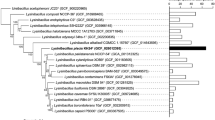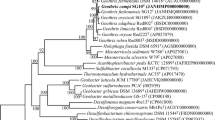Abstract
A novel Gram-strain positive, aerobic, actinobacterial strain, designated CF11/1T, was isolated from a sand sample obtained in the Sahara Desert, Chad. The black-pigmented isolate was aerobic and exhibited optimal growth from 25 to 35 °C at pH 6.0–8.0 and with 0–8 % (w/v) NaCl, indicating that it is a halotolerant mesophile. Chemotaxonomic and molecular characteristics of the isolate matched those described for members of the genus Geodermatophilus. The G+C content in the genome was 74.4 mol%. The peptidoglycan contained meso-diaminopimelic acid as diagnostic diaminoacid. The main phospholipids were diphosphatidylglycerol, phosphatidylcholine, phosphatidylethanolamine, phosphatidylinositol and a minor fraction of phosphatidylglycerol; MK-9(H4) was the dominant menaquinone, and galactose was detected as a diagnostic sugar. The major cellular fatty acid was branched-chain saturated acid iso-C16:0. Analysis of 16S rRNA gene sequences showed 95.3–98.6 % pairwise sequence identity with the members of the genus Geodermatophilus. Based on phenotypic and chemotaxonomic properties, as well as phylogenetic distinctiveness, the isolate represents a novel species, Geodermatophilus africanus, with the type strain CF11/1T (DSM 45422 = CCUG 62969 = MTCC 11556).


Similar content being viewed by others
References
Castresana J (2000) Selection of conserved blocks from multiple alignments for their use in phylogenetic analysis. Mol Biol Evol 17:540–552
Collins MD, Pirouz T, Goodfellow M, Minnikin DE (1977) Distribution of menaquinones in actinomycetes and corynebacteria. J Gen Microbiol 100:221–230
De Ley J, Cattoir H, Reynaerts A (1970) The quantitative measurement of DNA hybridization from renaturation rates. Eur J Biochem 12:133–142
Favet J, Lapange A, Giongo A, Kennedy S, Aung Y–Y, Cattaneo A, Davis-Richarson AG, Brown CT, Kort R, Brumsack H-J, Schnetger B, Chappell A, Kroijenga J, Beck A, Schwibbert K, Mohamed AH, Kirchner T, Dorr de Quadros P, Tripplett EW, Broughton WJ, Gorbushina AA (2013) Microbial hitchhikers on intercontinental dust: catching a lift in Chad. ISME J 7:850–867
Giongo A, Favet J, Lapanje A, Gano KA et al (2013) Microbial hitchhikers on intercontinental dust: high-throughput sequencing to catalogue microbes in small sand samples. Aerobiologia 29:71–84
Gordon RE, Smith MM (1955) Proposed group of characters for the separation of Streptomyces and Nocardia. J Bacteriol 69:147–150
Gregersen T (1978) Rapid method for distinction of gram-negative from positive bacteria. Appl Microbiol Biotechnol 5:123–127
Hess PN, De Moraes Russo CA (2007) An empirical test of the midpoint rooting method. Biol J Linn Soc 92:669–674
Huss VAR, Fest H, Schleifer KH (1983) Studies on the spectrophotometric determination of DNA hybridization from renaturation rates. Syst Appl Microbiol 4:184–192
Ishiguro EE, Fletcher DW (1975) Characterization of Geodermatophilus strains isolated from high altitude Mount Everest soils. Mikrobiologika 12:99–108
Ishiguro EE, Wolfe RS (1970) Control of morphogenesis in Geodermatophilus: ultrastructural studies. J Bacteriol 104:566–580
Ivanova N, Sikorski J, Jando M, Munk C, Lapidus A, Glavina Del Rio T, Copeland A, Tice H, Cheng JF, Lucas S et al (2010) Complete genome sequence of Geodermatophilus obscurus type strain (G-20T). Stand Genomic Sci 2:158–167
Jin L, Lee HG, Kim HS, Ahn CY, Oh HM (2013) Geodermatophilus soli sp. nov. and Geodermatophilus terrae sp. nov., two novel actinobacteria isolated from grass soil. Int J Syst Bacteriol. doi:10.1099/ijs.0.048892-0
Kroppenstedt RM (1982) Separation of bacterial menaquinones by HPLC using reverse phase (RP18) and a silver loaded ion exchanger. J Liq Chromatogr 5:2359–2387
Kroppenstedt RM, Goodfellow M (2006) The family Thermomonosporaceae: Actinocorallia, Actinomadura, Spirillispora and Thermomonospora. In: Dworkin M, Falkow S, Schleifer KH, Stackebrandt E (eds) The prokaryotes. Archaea and Bacteria: Firmicutes, Actinomycetes, 3rd edn, vol 3, Springer, New York, pp. 682–724
Lechevalier MP, Lechevalier HA (1970) Chemical composition as a criterion in the classification of aerobic actinomycetes. Int J Syst Bacteriol 20:435–443
Lee C, Grasso C, Sharlow MF (2002) Multiple sequence alignment using partial order graphs. Bioinformatics 18:452–464
Luedemann GM (1968) Geodermatophilus, a new genus of the Dermatophilaceae (Actinomycetales). J Bacteriol 96:1848–1858
Meier-Kolthoff JP, Göker M, Spröer C, Klenk HP (2013) When should a DDH experiment be mandatory in microbial taxonomy? Arch Microbiol. doi:10.1007/s00203-013-0888-4
Mesbah M, Premachandran U, Whitman WB (1989) Precise measurement of the G+C content of deoxyribonucleic acid by high-performance liquid chromatography. Int J Syst Bacteriol 39:159–167
Minnikin DE, O’Donnell AG, Goodfellow M, Alderson G, Athalye M, Schaal K, Parlett JH (1984) An integrated procedure for the extraction of bacterial isoprenoid quinones and polar lipids. J Microbiol Methods 2:233–241
Montero-Calasanz MC, Göker M, Pötter G, Rohde M, Spröer C, Schumann P, Gorbushina AA, Klenk HP (2012) Geodermatophilus arenarius sp. nov., a xerophilic actinomycete isolated from Saharan desert sand in Chad. Extremophiles 16:903–909
Montero-Calasanz MC, Göker M, Rohde M, Schumann P, Pötter G, Spröer C, Gorbushina AA, Klenk HP (2013a) Geodermatophilus siccatus sp. nov., isolated from arid sand of the Saharan desert in Chad. Antonie Van Leeuwenhoek 103:449–456
Montero-Calasanz MC, Göker M, Pötter G, Rohde M, Spröer C, Schumann P, Gorbushina AA, Klenk HP (2013b) Geodermatophilus saharensis sp. nov., isolated from sand of the Saharan desert in Chad. Arch Microbiol 195:153–159
Montero-Calasanz MC, Göker M, Broughtonc WJ, Cattaneoc A, Favetc J, Pötter G, Rohde M, Spröer C, Schumann P, Klenk H-P, Gorbushina AA (2013c) Geodermatophilus tzadiensis sp. nov., a UV radiation-resistant bacterium isolated from sand of the Saharan desert. Syst Appl Microbiol 36:177–182
Montero-Calasanz MC, Göker M, Pötter G, Rohde M, Spröer C, Schumann P, Klenk HP, Gorbushina AA (2013d) Geodermatophilus telluris sp. nov., a novel actinomycete isolated from Saharan desert sand in Chad. Int J Syst Evol Microbiol 63:2254–2259
Montero-Calasanz MC, Göker M, Pötter G, Rohde M, Spröer C, Schumann P, Gorbushina AA, Klenk HP (2013e) Geodermatophilus normandii sp. nov., isolated from Saharan desert sand. Int J Syst Evol Microbiol. doi:10.1099/ijs.0.051201-0
Nie GX, Ming H, Li S, Zhou EM, Cheng J, Yu TT, Zhang J, Feng HG, Tang SK, Li WJ (2012) Geodermatophilus nigrescens sp. nov., isolated from a dry-hot valley. Antonie Van Leeuwenhoek 101:811–817
Normand P (2006) Geodermatophilaceae fam. nov., a formal description. Int J Syst Evol Microbiol 56:2277–2278
Normand P, Benson DR (2012). Genus I. Geodermatophilus Luedemann 1968. 1994. In: Goodfellow M, Kämpfer P, Busse HJ, Trujillo ME, Suzuki KI, Ludwig W, Whitman WB (eds) Bergey’s Manual of Systematic Bacteriology, 2nd edn, vol 5, The Actinobacteria Part 1, Springer, New York, pp 528–530
Normand P, Orso S, Cournoyer B, Jeannin P, Chapelon C, Dawson J, Evtushenko L, Misra AK (1996) Molecular phylogeny of the genus Frankia and related genera and emendation of the family Frankinaceae. Int J Syst Bacteriol 46:1–9
Pattengale ND, Alipour M, Bininda-Emonds ORP, Moret BME, Stamatakis A (2009) How many bootstrap replicates are necessary? Lect Notes Comput Sci 5541:184–200
Pelczar MJ Jr (ed) (1957) Manual of microbiological methods. McGraw-Hill Book Co., New York
Rainey FA, Ward-Rainey N, Kroppenstedt RM, Stackebrandt E (1996) The genus Nocardiopsis represents a phylogenetically coherent taxon and a distinct actinomycete lineage: proposal of Nocardiopsiaceae fam. nov. Int J Syst Bacteriol 46:28–96
Rice P, Longden I, Bleasby A (2000) EMBOSS: the European molecular biology open software suite. Trends Genet 16:276–277
Sasser M (1990) Identification of bacteria by gas chromatography of cellular fatty acids. USFCC Newsl 20:16
Schleifer KH, Kandler O (1972) Peptidoglycan types of bacterial cell walls and their taxonomic implications. Bacteriol Rev 36:407–477
Shirling EB, Gottlieb D (1966) Methods for characterization of Streptomyces species. Int J Syst Bacteriol 16:313–340
Skerman VBD, McGowan V, Sneath PHA (1980) Approved lists of bacterial names. Int J Syst Bacteriol 30:225–420
Stackebrandt E, Ebers J (2006) Taxonomic parameter revisited: tarnished gold standards. Microbiol Today 33:152–155
Stamatakis A, Hoover P, Rougemont J (2008) A rapid bootstrap algorithm for the RAxML web servers. Syst Biol 57:758–771
Staneck JL, Roberts GD (1974) Simplified approach to identification of aerobic actinomycetes by thin-layer chromatography. Appl Microbiol 28:226–231
Swofford DL (2002) PAUP*: Phylogenetic Analysis Using Parsimony (*and Other Methods), Version 4.0 b10. Sinauer Associates, Sunderland
Tindall BJ (1990) A comparative study of the lipid composition of Halobacterium saccharovorum from various sources. Syst Appl Microbiol 13:128–130
Urzì C, Brusetti L, Salamone P, Sorlini C, Stackebrandt E, Daffonchio D (2001) Biodiversity of Geodermatophilaceae isolated from stones and monuments in the Mediterranean basin. Environ Microbiol 3:471–479
Urzì C, La Cono V, Stackebrandt E (2004) Design and application of two oligonucleotide probes for the identification of Geodermatophilaceae strains using fluorescence in situ hybridization (FISH). Environ Microbiol 6:678–685
Vaas LAI, Sikorski J, Michael V, Göker M, Klenk HP (2012) Visualization and curve-parameter estimation strategies for efficient exploration of phenotype microarray kinetics. PLoS ONE 7(4):e34846
Validation List no. 150 List of new names and new combinations previously effectively, but not validly published. Int J Syst Bacteriol March 2013
Validation List no. 151 List of new names and new combinations previously effectively, but not validly published. Int J Syst Bacteriol May 2013
Wayne LG, Brenner DJ, Colwell RR, Grimont PAD, Kandler O, Krichevsky MI, Moore LH, Moore WEC, Murray RGE, Stackebrandt E, Starr MP, Trüper HG (1987) Report of the ad hoc committee on reconciliation of approaches to bacterial systematics. Int J Syst Bacteriol 37:463–464
Zhang Y-Q, Chen J, Liu H-Y, Zhang Y-Q, Li W-J, Yu L-Y (2011) Geodermatophilus ruber sp. nov., isolated from rhizosphere soil of a medical plant. Int J Syst Evol Microbiol 61:190–193
Acknowledgments
We would like to gratefully acknowledge the help of Agathe Stricker of the International Committee of the Red Cross in Geneva, Switzerland, for organizing the collection of the sand samples from which strain CF11/1T was isolated. Jocelyne Favet, Arlette Cattaneo and William J. Broughton of the Laboratoire de Biologie Moléculaire de Plantes Supérieures (University of Geneva, Switzerland) are acknowledged for their contribution to the isolation of the strain, Bettina Sträubler and Birgit Grün (DSMZ, Braunschweig), for their help in DNA–DNA hybridization analysis and Brian J. Tindall (DSMZ, Braunschweig) for his guidance in chemotaxonomic analyses. M.C. Montero-Calasanz is the recipient of a postdoctoral contract from European Social Fund Operational Programme (2007–2013) for Andalusia and a DSMZ postdoctoral fellowship.
Author information
Authors and Affiliations
Corresponding authors
Electronic supplementary material
Below is the link to the electronic supplementary material.
Fig. S1
The parameter “Maximum Height” estimated from the respiration curves as measured by an OmniLog phenotyping device and discretized and visualized as a heatmap using the opm package. Plates and substrates are rearranged according to their overall similarity (as depicted using the row and column dendrograms). Orange colour indicates positive reaction; purple colour indicate negative reaction; white colour indicate ambiguous reaction. Letters (A/B) indicate each replicate of experiment (PDF 61 kb)
Fig. S2
Polar lipids profile of Geodermatophilus africanus sp. nov. CF11/1T, after separation by two-dimensional TLC. Plate was sprayed with molydatophosphoric acid for detection of total polar lipid. DPG, diphosphadidylglycerol; PG, phosphadidylglycerol; PE, phosphatidethanolamine; PC, phosphatidylcholine; PI, phosphatidylinositol; GL, unknown glycolipid; L, unknown lipid (TIFF 277 kb)
Rights and permissions
About this article
Cite this article
Montero-Calasanz, M.C., Göker, M., Pötter, G. et al. Geodermatophilus africanus sp. nov., a halotolerant actinomycete isolated from Saharan desert sand. Antonie van Leeuwenhoek 104, 207–216 (2013). https://doi.org/10.1007/s10482-013-9939-8
Received:
Accepted:
Published:
Issue Date:
DOI: https://doi.org/10.1007/s10482-013-9939-8




